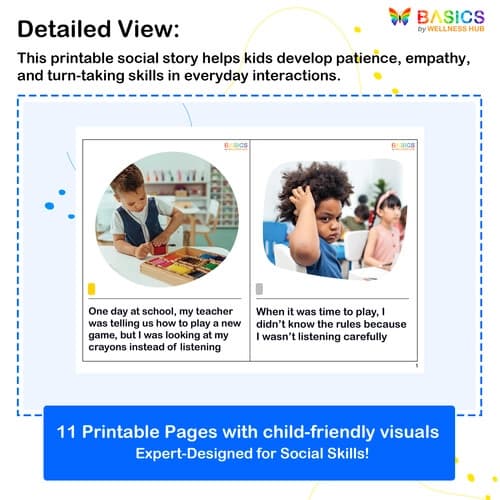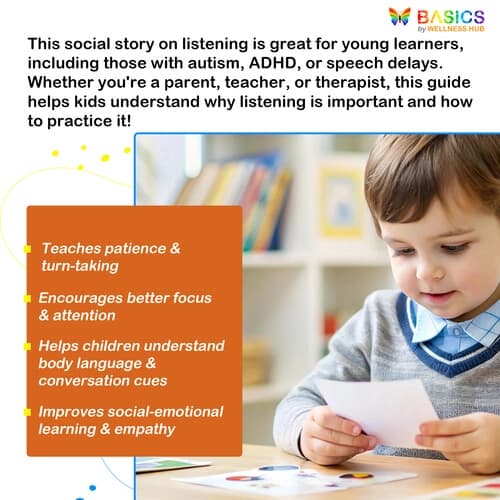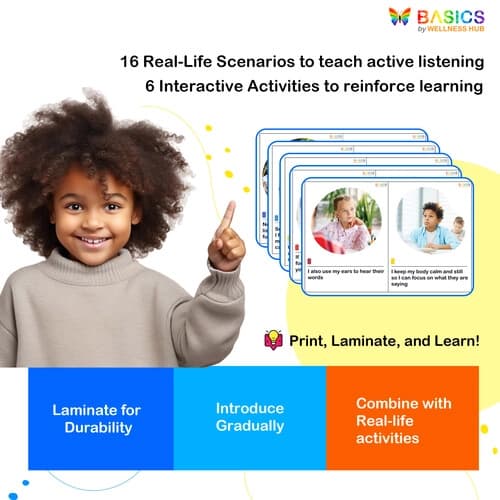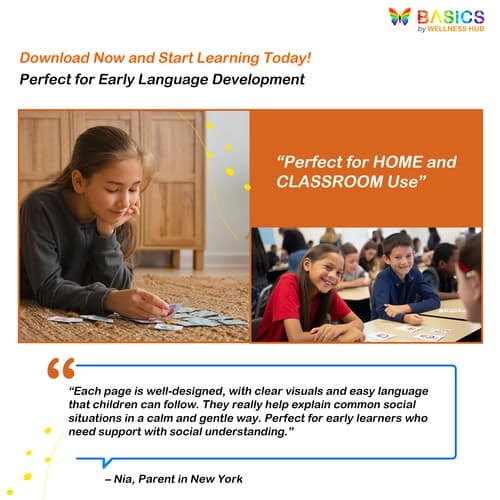



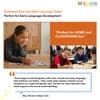
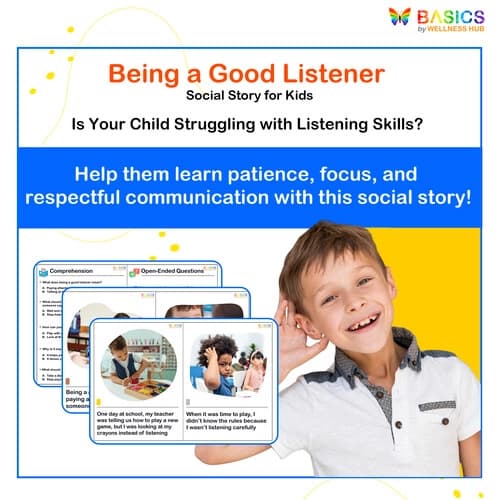
Being a Good Listener – Social Story for Kids’ Communication Skills
₹80
₹160
50% off
0 (0 ratings)
Grade Levels
Pre-K - Grade 3 (Ages 4-9)
Content Overview
Format: Printable PDF, Total Pages: 11, Features (≤15 words): 16 real-life segments, kid-friendly visuals, interactive exercises
Categories
Pages from the Resource
Teach children how to be a good listener with this social story focused on polite communication and empathy. With 16 real-life scenarios, interactive exercises, and engaging illustrations, kids learn active listening skills, body language awareness, and respectful conversation habits. Ideal for children with autism, ADHD, or speech delays—perfect for home, school, or therapy.
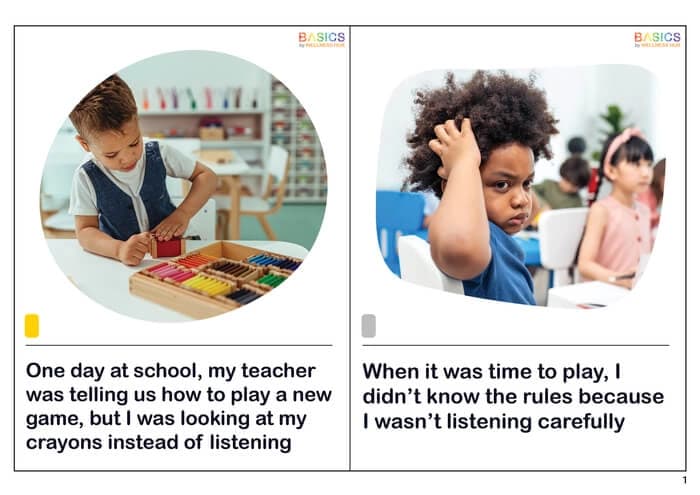
Page 1
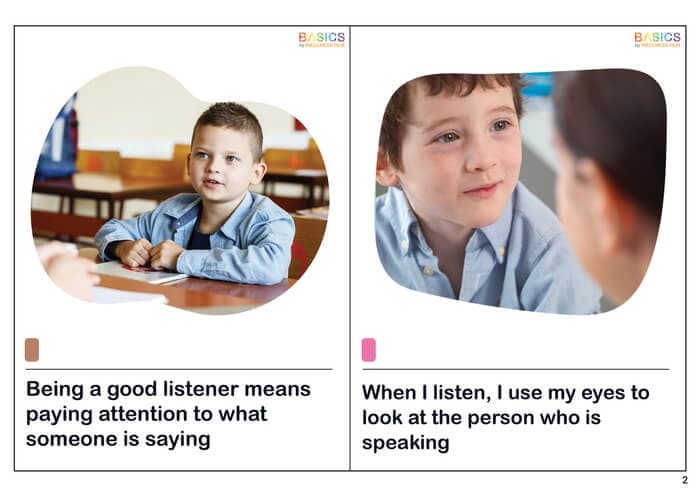
Page 2
What Users Say
0
0 ratings
5
0+
4
0+
3
0+
2
0+
1
0+
5 Stars
Product is Good to use.
1 year ago
Varsha Parent
Similar Products
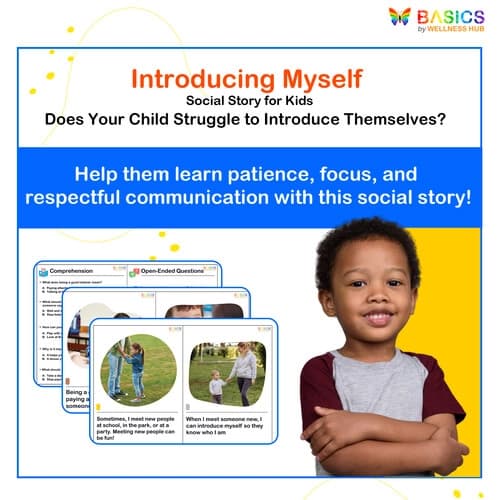
Introducing Myself – Free Social Story for Kids’ Communication Skills
₹ 80.00
₹ 160.00
50% off
4.8 (60 ratings)
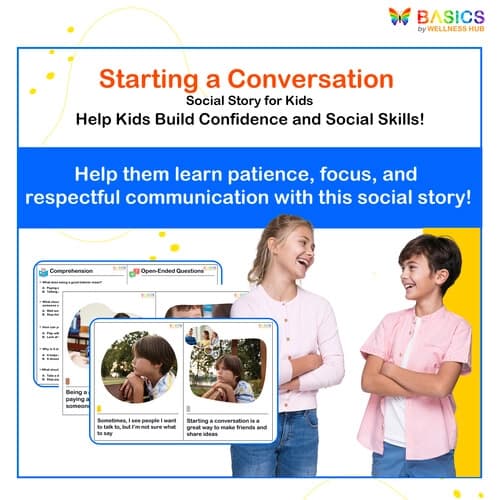
Starting Conversations – Social Story for Kids' Communication Skills
₹ 80.00
₹ 160.00
50% off
5.0 (56 ratings)
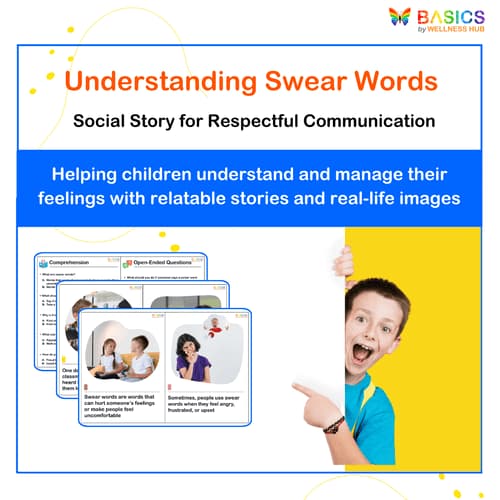
Understanding Swear Words – Social Story for Respectful Communication
₹ 80.00
₹ 160.00
50% off
4.9 (48 ratings)
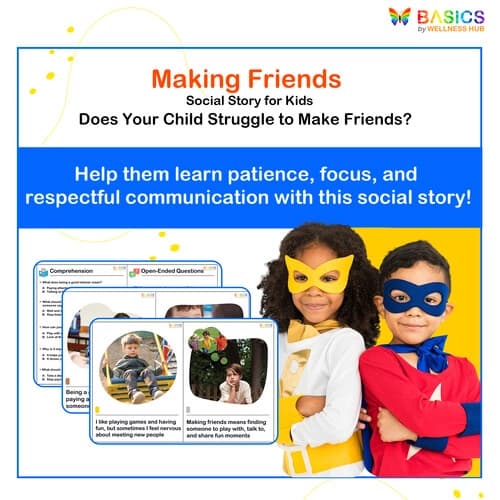
Making Friends – Social Story for Building Social Skills
₹ 80.00
₹ 160.00
50% off
4.9 (52 ratings)
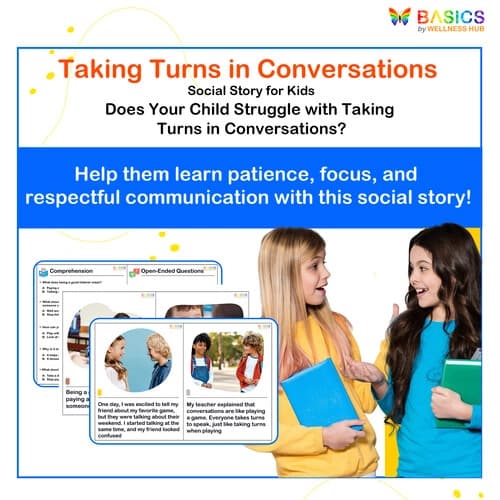
Taking Turns in Conversations – Social Story for Kids
₹ 80.00
₹ 160.00
50% off
4.9 (60 ratings)
About the Product
Introduction
Listening is a vital skill for children to develop, helping them form positive relationships, understand instructions, and show empathy in daily interactions. Yet many children, including those with autism, ADHD, or other speech and language challenges, may struggle with active listening—they may interrupt, miss important cues, or find it difficult to maintain focus.
"Being a Good Listener – Social Story for Kids" is designed to bridge these gaps by providing step-by-step guidance on becoming an attentive and respectful listener. Through 16 real-life scenarios, illustrations, and interactive exercises, children can see clear examples of how to:
- Wait for their turn to speak
- Show they’re listening using body language and facial expressions
- Use polite conversation habits like asking questions and giving feedback
- Respond appropriately to what they hear
Parents, educators, and therapists can use this resource to reinforce polite communication, empathy, and respectful conversations in various settings—from home and school to speech therapy sessions.
Product Details
- Format: Printable PDF
- Total Pages: 11
- Segments: 16 real-life scenarios that depict everyday listening challenges and solutions
- Features:
- Engaging illustrations: Enhance comprehension and keep children’s attention
- Interactive exercises: Role-play prompts and reflection questions to encourage active participation
- Child-friendly language: Clear, simple text appropriate for kids aged 4–9
- Practical examples: Shows children how to handle common listening situations (e.g., classroom instructions, friendly chats, family discussions)
This easy-to-use social story can be printed or read digitally, making it accessible for home, classroom, or therapy use.
Educational Benefits
- Teaches Active Listening Techniques
- Illustrates how to maintain eye contact, nod in acknowledgment, and ask clarifying questions to show genuine interest.
- Helps children understand body language cues that signal respectful engagement (e.g., leaning in slightly, facing the speaker).
- Develops Communication & Empathy
- Reinforces the idea that good listening helps others feel heard and valued.
- Encourages children to take turns speaking, avoid interrupting, and practice patience when someone else is talking.
- Supports Children with Special Needs
- Structured approach is beneficial for kids with autism, ADHD, or speech delays.
- Simple, direct text and visual aids break down the process of listening into manageable steps.
- Improves Focus & Attention
- Scenarios emphasize waiting until a speaker is finished and concentrating on what’s being said.
- Role-play exercises help children practice self-control during conversations.
- Applies to Real-Life Situations
- Addresses classroom listening during instructions, playground interactions, and home conversations.
- Prompts children to reflect on how well they listened and discuss
Instructions for Use
1. Read the Social Story Aloud
- Begin by sitting with the child and reading each of the 16 real-life scenarios.
- Pause to discuss each scenario’s illustrations, ensuring the child understands the context and the listening behavior
- Invite questions and reflections about why listening is essential in that particular scenario.
2. Engage in the Interactive Exercises
- After each scenario, look for activity prompts (e.g., role-playing a conversation, asking the child to practice nodding or waiting before speaking).
- Use props (stuffed animals or toys) to act out common listening situations, letting the child practice the skill in a fun, low-pressure
- If children feel uncomfortable or unsure, guide them gently with positive reinforcement (“I like how you waited for me to finish!”).
3. Encourage Real-Life Application
- Prompt the child to use the lessons in daily routines, such as listening to class instructions, family discussions, or reading storybooks together.
- Acknowledge and praise the child’s efforts when they show good listening behaviors (“Thank you for waiting for me to finish talking!”).
- If the child forgets, remind them of a scenario from the story and discuss how they could handle it differently next time.
4. Revisit & Reinforce
- Re-read the social story regularly (e.g., weekly or monthly) to reinforce the concepts.
- Use visual reminders like posters or simple bullet points summarizing the best practices for being a good listener.
- Discuss progress with the child, celebrating small improvements and setting new goals (e.g., listening carefully to the teacher for an entire lesson).
Tips for Maximizing Success
- Model good listening skills yourself: let the child see you making eye contact, asking clarifying questions, and refraining from interruptions.
- Collaborate with other caregivers: share the story’s key messages with teachers, family members, or therapists so they can help maintain consistency in reinforcing good listening behaviors.
Activities Using the Resource
These hands-on activities complement the “Being a Good Listener” social story, helping children apply and reinforce the concepts they’ve learned about active listening, body language, and respectful communication.
1. Role-Playing “Active Listening” Scenarios
Objective: Encourage children to practice good listening habits—like waiting, asking clarifying questions, and making eye contact—in everyday contexts.
- Materials:
- The social story as a reference
- Optional simple props (stuffed animals or toys) to simulate conversational partners
- How to Play:
- After reading the story together, choose a scenario (e.g., talking with a friend, listening to a teacher’s instructions).
- Act out the scene, with the child taking on the role of the listener.
- Emphasize quietly waiting for the speaker to finish, nodding, and asking relevant questions.
- Praise correct listening behaviors (e.g., “Great job waiting your turn to speak!”) and gently correct
2. “Echo Game” for Following Directions
Objective: Enhance concentration and memory by having children repeat back important details.
- Materials:
- Simple instructions or directions
- How to Play:
- Give short instructions like “Touch your nose, then clap your hands.”
- Ask the child to repeat the instructions before performing them.
- Increase complexity (e.g., add more steps) as the child’s listening improves.
- Relate it back to the social story’s message: “We listen carefully and repeat what we heard to show we understand.”
3. “Listening Chart” for Tracking Progress
Objective: Encourage consistent practice of listening skills and self-reflection.
- Materials:
- A simple chart or checklist
- How to Play:
- Each day or week, focus on a specific listening goal (e.g., “I will wait until my friend finishes speaking,” or “I will keep eye contact for at least 5 seconds”).
- Mark or sticker the chart every time the child successfully demonstrates the target skill.
- Review the chart together to celebrate achievements and set new goals.
4. “Ask & Answer” Conversation Practice
Objective: Teach children how to ask polite questions and respond appropriately.
- Materials:
- Question prompts (can be found in the resource or created by an adult)
- How to Play:
- Write or pick simple questions like, “What’s your favorite color?” or “How was your day?”
- Have the child ask a question and practice listening without interrupting.
- The adult or another child answers, demonstrating good listening in return.
- Rotate roles, ensuring the child experiences both speaking and listening.
5. “Who, What, When, Where, Why” Listening Game
Objective: Reinforce comprehension by focusing on key details in a short story or spoken instruction.
- Materials:
- A short story, video clip, or instructions you can read aloud
- How to Play:
- Read or watch a short piece of content together.
- Ask who, what, when, where, or why questions about it.
- The child must listen carefully and recall details.
- Encourage them to ask clarifying questions if they’re unsure.
- Relate it back to the good listener concept from the social story.
FAQs
Q1: Who is this social story designed for?
A1: This resource targets children aged 4–9, especially those who need explicit instruction on listening skills. It’s particularly beneficial for children with autism, ADHD, or other communication difficulties. Parents, teachers, and therapists can use it to reinforce respectful listening at home, school, or therapy sessions.
Q2: How often should I use this social story?
A2: Regular exposure helps children internalize concepts. You can review one scenario or activity daily or focus on a specific listening goal each week. Repetition builds consistency and reinforces the child’s progress.
Q3: Can older or younger children also benefit?
A3: Yes! While best suited for ages 4–9, you can simplify scenarios for younger kids or discuss more complex conversation skills for older children. Adjust the depth of explanation and role-play based on each child’s developmental level.
Q4: Is this suitable for children with special needs?
A4: Absolutely. The structured narrative and visual examples are particularly helpful for kids with autism, ADHD, or other speech and language challenges who benefit from clear, direct instruction on social norms.
Q5: What if my child shows resistance or disinterest?
A5: Keep sessions short, positive, and praise small successes. Incorporate fun elements like stickers, games, or the child’s favorite toy to encourage engagement. Model good listening skills yourself, showing enthusiasm and patience.
Q6: Do I need special materials?
A6: No special materials are required beyond the printable PDF and common household items (e.g., pencils, stickers for charts). Most activities rely on role-play, basic discussion, and interaction. You can print as many copies as needed for home, classroom, or therapy.
Usage Rights and Restrictions
- Allowed Usage:
- Personal, educational, or therapeutic use by parents, teachers, and therapists.
- Printing multiple copies for home or classroom
- Digital use on tablets or computers during sessions.
- Not Allowed:
- Reselling, redistributing, or uploading this social story for free or commercial gain.
- Modifying the content for commercial purposes without explicit permission.
- Sharing publicly in a way that bypasses the original source or licensing.
For bulk licensing or special permissions, please contact us directly.
Conclusion
The “Being a Good Listener – Social Story for Kids” provides a step-by-step framework for children to develop active listening, focus, and respectful communication. By using relatable scenarios, engaging illustrations, and hands-on activities, children are encouraged to practice these skills in real life—whether in classrooms, home environments, or peer settings.
Through consistent application, role-play, and positive reinforcement, this social story helps children master the art of listening, leading to better understanding, fewer misunderstandings, and stronger relationships with peers and adults. If you have further questions or need adaptations for specific needs, feel free to adjust the materials or contact us for guidance
